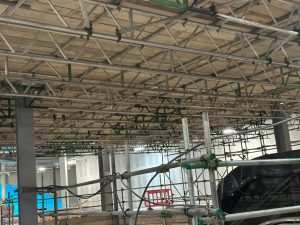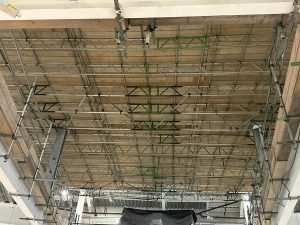Maintaining scaffolding equipment is crucial for ensuring both the safety of workers and the longevity of the equipment itself. Regular maintenance can prevent accidents, reduce downtime, and save costs in the long run by avoiding the need for frequent replacements.
Proper care and attention to scaffolding equipment not only extend its useful life but also ensure that it remains compliant with safety standards.
The benefits of well-maintained scaffolding are manifold. It ensures a safe working environment, which is paramount in construction. Furthermore, it maximises efficiency by reducing the risk of equipment failure and consequent project delays.
This blog will outline essential practices for maintaining scaffolding equipment to enhance both its longevity and safety.
Regular Inspection
Frequent inspections are the cornerstone of scaffolding maintenance. Daily checks are vital to ensure that there are no immediate safety hazards, while weekly and monthly inspections can help identify more subtle signs of wear and tear.
Key areas to focus on include joints, welds, bolts, and couplers, as these are critical for the structural integrity of the scaffolding.
Keeping detailed records of these inspections is equally important. Documentation helps track the condition of the equipment over time and ensures that any recurring issues are addressed promptly.
This practice not only helps in maintaining safety but also proves invaluable during compliance audits and safety reviews.
Cleaning and Storage
Proper cleaning of scaffolding equipment can prevent the accumulation of debris and rust, which can weaken the structure over time.
Regular cleaning routines should be established, using appropriate methods to remove dirt and prevent corrosion. This is especially important for metal components, which are prone to rust if not properly maintained.
Storage conditions play a significant role in the longevity of scaffolding equipment. It is essential to store scaffolding in dry, well-ventilated areas to prevent moisture damage.
Additionally, equipment should be kept off the ground and away from direct exposure to the elements, particularly during winter and rainy seasons, to avoid unnecessary wear and tear.
Component Care
Each component of the scaffolding requires specific attention. Frames and tubes should be regularly checked for bends, cracks, and rust, which can compromise the structural integrity.
Prompt repair or replacement of damaged parts is essential to maintain safety standards. Similarly, platforms and planks must be free from splits, rot, or any other form of degradation that could pose a hazard to workers.
Fasteners and connectors, often the unsung heroes of scaffolding structures, need regular tightening and replacement when worn out.
These small yet crucial parts hold the entire system together, and their failure can lead to catastrophic accidents. Therefore, a meticulous approach to their maintenance is necessary to ensure the overall stability of the scaffolding.
Training and Education
Regular training sessions for staff on proper maintenance techniques are essential for ensuring that everyone involved understands the importance of equipment care.
These sessions should cover the basics of inspection, cleaning, and storage, as well as more advanced repair techniques. Keeping staff well-informed and skilled in maintenance practices can significantly reduce the risk of accidents.
Staying updated with industry standards and regulations is another crucial aspect of scaffolding maintenance.
New safety protocols and technological advancements can offer more efficient and safer ways to maintain equipment. Therefore, continuous education and training are vital for maintaining a high standard of safety and operational efficiency.
Repair and Replacement
Knowing when to repair and when to replace scaffolding components is crucial for both safety and cost-effectiveness.
Minor issues, such as small cracks or loose bolts, can often be repaired on-site. However, more significant damage, such as severe rust or structural bends, may require replacement to ensure safety.
For complex repairs, it is advisable to engage certified professionals who have the expertise to handle intricate scaffolding structures.
Maintaining a stock of essential replacement parts can also help minimise downtime during maintenance. Efficient inventory management ensures that necessary parts are readily available, allowing for prompt repairs and reducing project delays.
Safety Protocols
Ensuring workers use appropriate safety gear during maintenance is fundamental to preventing accidents.
This includes helmets, gloves, and harnesses, depending on the specific tasks being performed. Safety gear not only protects workers but also promotes a culture of safety within the organisation.
Marking areas under maintenance is another critical safety measure. This helps prevent unauthorised access and potential accidents.
Additionally, establishing clear emergency procedures for handling scaffolding-related incidents ensures that any issues are dealt with swiftly and effectively, minimising the risk of serious injuries.
Conclusion
Regular maintenance of scaffolding equipment is essential for ensuring its longevity and the safety of those who use it.
By adhering to a structured maintenance schedule and implementing thorough inspection, cleaning, and storage practices, the risks associated with scaffolding can be significantly reduced.
Investing time and resources into proper scaffolding maintenance not only enhances safety but also proves cost-effective in the long run.
Regular professional inspections and continuous staff training further reinforce a robust maintenance regime, ensuring that scaffolding remains reliable and secure.




